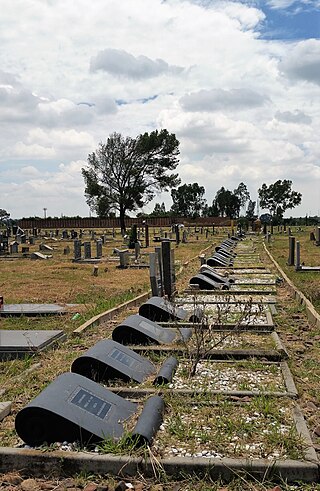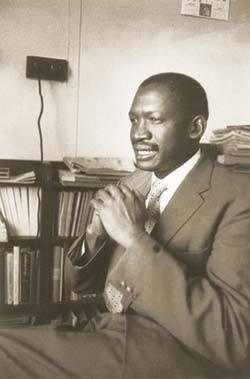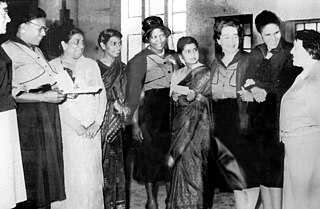
Soweto is a township of the City of Johannesburg Metropolitan Municipality in Gauteng, South Africa, bordering the city's mining belt in the south. Its name is an English syllabic abbreviation for South Western Townships. Formerly a separate municipality, it is now incorporated in the City of Johannesburg Metropolitan Municipality, and one of the suburbs of Johannesburg.

The Sharpeville massacre occurred on 21 March 1960 at the police station in the township of Sharpeville in the then Transvaal Province of the then Union of South Africa. After demonstrating against pass laws, a crowd of about 7,000 protesters went to the police station. Sources disagree as to the behaviour of the crowd: some state that the crowd was peaceful, while others state that the crowd had been hurling stones at the police and that the mood had turned "ugly". The South African Police (SAP) opened fire on the crowd when the crowd started advancing toward the fence around the police station; tear-gas had proved ineffectual. There were 249 victims in total, including 29 children, with 69 people killed and 180 injured. Some were shot in the back as they fled.

Robert Mangaliso Sobukwe was a prominent South African anti-apartheid revolutionary and founding member of the Pan Africanist Congress (PAC), serving as the first president of the organization.

The Vaal Triangle is a triangular area formed by Vereeniging, Vanderbijlpark and Sasolburg about 60 km south of Johannesburg, South Africa. The area forms a substantial urban complex. Meyerton, just north of Vereeniging, is also generally included in the complex, and residents of Sharpeville, Boipatong, Bophelong, the greater Sebokeng area, Three Rivers, Heidelberg, Deneysville and Potchefstroom also generally tend to consider themselves to live in the Vaal Triangle. The area straddles the Vaal River and is a major industrial region, which is home to former Iron and Steel Corporation Iscor, now ArcelorMittal South Africa, and Sasol, respectively the steel and petrochemical processing facilities.

Vereeniging is a city located in the south of Gauteng province, South Africa, situated where the Klip River empties into the northern loop of the Vaal River. It is also one of the constituent parts of the Vaal Triangle region and was formerly situated in the Transvaal province. The name Vereeniging is derived from the Dutch word meaning "association".
Sebokeng locally called Zweni by residents, is a middle-class township in the Emfuleni Local Municipality in southern Gauteng, South Africa near the industrial cities of Vanderbijlpark and Vereeniging. Other neighboring townships include Evaton to the north and Sharpville to the south.
Sasolburg is the fourth largest city(After Bloemfontein, Welkom and Kroonstad) within the Metsimaholo Local Municipality in the far north of the Free State province of South Africa. Sasolburg is further sub-divided into three areas: Sasolburg proper, Vaalpark and Zamdela.
In South Africa, pass laws were a form of internal passport system designed to segregate the population, manage urbanization and allocate migrant labor. Also known as the natives' law, pass laws severely limited the movements of black African citizens, and other people as well by restricting them to designated areas. Before the 1950s, this legislation largely applied to African men; attempts to apply it to women in the 1910s and 1950s were met with significant protests. Pass laws were one of the dominant features of the country's apartheid system until it was effectively ended in 1986. The pass document used in the enforcement of these laws was pejoratively called the dompas.

Apartheid was a system of institutionalised racial segregation that existed in South Africa and South West Africa from 1948 to the early 1990s. Apartheid was characterised by an authoritarian political culture based on baasskap, which ensured that South Africa was dominated politically, socially, and economically through minoritarianism by the nation's dominant minority white population. According to this system of social stratification, white citizens had the highest status, followed by Indians and Coloureds, then black Africans. The economic legacy and social effects of apartheid continue to the present day, particularly inequality.

Langa is a township in Cape Town, South Africa. Its name in Xhosa means "sun". The township was initially built in phases before being formally opened in 1927. It was developed as a result of South Africa's 1923 Urban Areas Act, which was designed to force Africans to move from their homes into segregated locations. Similar to Nyanga, Langa is one of the many areas in South Africa that were designated for Black Africans before the apartheid era. It is the oldest of such suburbs in Cape Town and was the location of much resistance to apartheid.

Internal resistance to apartheid in South Africa originated from several independent sectors of South African society and took forms ranging from social movements and passive resistance to guerrilla warfare. Mass action against the ruling National Party (NP) government, coupled with South Africa's growing international isolation and economic sanctions, were instrumental in leading to negotiations to end apartheid, which began formally in 1990 and ended with South Africa's first multiracial elections under a universal franchise in 1994.

The Emfuleni Local Municipality, founded in 1999, is one of three local municipalities comprising the Sedibeng District in Gauteng, South Africa. It is the westernmost local municipality in the District, and covers an area of 987 km2 at the heart of the Vaal Triangle. It is located in the former industrial heartland of Gauteng which created employment and wealth for Sebokeng, Vanderbijlpark, Vereeniging and Sharpeville. Its head offices are located at the corner of Klasie Havenga St and Frikkie Meyer Blvd, Vanderbijlpark.
This article covers the history of the Pan Africanist Congress of Azania, once a South African liberation movement and now a minor political party.
Boipatong Vanderbijlpark is a township in Gauteng, South Africa. It was established in 1955 to house black residents who worked in Vanderbijlpark and Vereeniging.

Duncan Village is a township in the Buffalo City Metropolitan Municipality in the Eastern Cape province of South Africa. The township is located about five kilometres away from the East London city business district (CBD). Duncan Village is divided into six wards, with each headed by a ward councillor. There are no clear divisions between the informal and formal parts of the township since most shacks are planted on the open spaces within formal houses.
Dr. Maitshwe Nchuape Aubrey Mokoape was a South African anti-apartheid activist and a leader of the Pan-Africanist Congress and Black Consciousness Movement. He was first arrested and detained at the age of 15. He studied and worked alongside political anti-apartheid activist Steve Biko. In post-apartheid South Africa, Mokoape became a physician.

The Federation of South African Women (FEDSAW) was a political lobby group formed in 1954. At FEDSAW's inaugural conference, a Women's Charter was adopted. Its founding was spear-headed by Lillian Ngoyi.

On 21 March 1985, on the 25th anniversary of the Sharpeville massacre, members of the South African Police opened fire on a crowd of people gathered on Maduna Road between Uitenhage and Langa township in the Eastern Cape, South Africa. The crowd had been attending a funeral of one of the six who had been slain by the apartheid police on 17 March 1985. They had gathered at Maduna Square and were heading towards the house where the funeral was held when the police blocked the road with two armoured vehicles and ordered the crowd to disperse. When the crowd failed to comply immediately, police opened fire on the crowd, killing 35 people and leaving 27 wounded. The incident became known as the Uitenhage/Langa massacre.

On 17 November 1985, 2000 residents from Mlungisi township in Queenstown, Eastern Cape, gathered in Nonzwakazi Methodist Church to hear back from the Local Residents Association, who, in early November, had met with the Department of Education and Training, the Queenstown municipality, the Eastern Cape Development Board, and the Queenstown Chamber of Commerce to discuss the end of the consumer boycott. The meeting was short-lived as members of the Queenstown branch of the South African Police stormed into the meeting and opened fire on the residents. In the ensuing conflict between police and residents, 14 people were shot dead and 22 were injured. This incident is known as the 1985 Queenstown Massacre.
Roshnee is an Indian township associated with Vereeniging in Gauteng.















